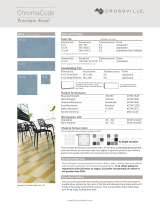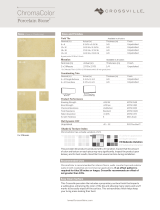
TILE SPECIFICATIONS
STANDARDS & REGULATIONS
TILE SPECIFICATIONS PAGE 1 OF 3
PORCELAIN/CERAMIC TEST RESULTS
This tile has been tested by the Tile Council of North America with DCOF AcuTest
SM
, a new industry standard used to measure
dynamic coefcient of friction (DCOF). DCOF AcuTest
SM
assesses a product’s suitability for the commercial environment and
the specic usability needs of the application.
A Measure of Friction
Friction is the force that resists the sliding motion of one surface against another. Contaminants, such as liquids, can alter
the measurement of friction. There are two types of friction: static (SCOF) and dynamic (DCOF). SCOF is the ratio of forces
necessary to start two surfaces sliding. This is what the former American Society for Testing and Materials (ASTM) C1028
static test measured. DCOF is the ratio of forces necessary to keep two surfaces sliding.
Industry Testing
The DCOF AcuTest
SM
because it’s the most accurate method for determining whether or not a product is suitable for a
commercial environment.
• Similar to measuring the speed of a car in both mph and kph, friction can also be measured on two scales (DCOF and
SCOF). The new 0.42 wet (DCOF) is replacing the old reference of 0.60 COF wet, which has long been the benchmark
for friction in commercial applications.
• The new, more stringent DCOF AcuTest
SM
uses a portable robot that, unlike ASTM C1028, gives realistic values on very
smooth surfaces.
Water Absorption, ASTM C373-88
Water absorption is measured using ASTM C373-88. Individual tiles are weighed, saturated with water, then weighed again.
The percent difference between the two conditions is referred to as the water absorption value. Tiles are classied according to
water absorption percentages as follows:
value. Tiles are classied according to water absorption percentages as follows:
Impervious Tiles exhibiting 0.5% or less.
Vitreous Tiles exhibiting more than 0.5%, but not more than 3.0%.
Semi-Vitreous Tiles exhibiting more than 3.0%, but not more than 7.0%.
Non-Vitreous Tiles exhibiting more than 7.0%.
Scratch Hardness – Mohs Scale Ratings
The relative hardness of glazed tile is an important issue that should be addressed when selecting a tile. The test is performed
by scratching the surface of the tile with different minerals and subjectively assigning a “Mohs Scale of Mineral Hardness”
number to the glaze. The softest mineral used is talc (“1” rating)—the hardest is a diamond (“10” rating). Other minerals
of varying hardness providing Mohs Scale of Mineral Hardness values of 5 or more are suitable for most residential oor
applications. A value of 7 or greater is normally recommended for commercial applications.
Breaking Strength Porcelain Tile, ASTM C648-04
Ceramic tiles used on oors and walls must be able to withstand the expected load bearing capacity of various installations.
The tile industry uses ASTM C648-04 to determine the strength and durability of the tile. A force is applied to an unsupported
portion of the tile specimen until breakage occurs. The ultimate breaking strength is then recorded in pounds. Final selection of






